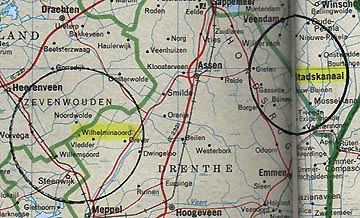
July 16, 2003 Wilhelminaoord, Drenthe, Holland – Yesterday Dutch crop circle researcher, Robert Boerman, who produces the website, www.dcca.nl, received a phone call about two crop circles in the same wheat field near Wilhelminaoord, Drenthe, Holland. The farmer is 60 years old and told Robert he had been working his fields for about forty years. He said he had never seen such patterns in his crops before and he was very happy that circles had finally come in his field. “That’s a different reaction than we are used to receiving from farmers!” Robert told me. Usually farmers are frustrated and angry.
The farmer was definite that the patterns had to have formed during the night of Saturday to Sunday, July 12 to 13 because Saturday night at 6 p.m. he was in the field and there was nothing to see. But the next morning at 9:30 a.m., he found the formations. He entered the field and said there were no footsteps or other tracks that would suggest the work of humans. ‘Nothing, nothing at all,’ he said. He showed Robert in the field today that if he put his booted foot on the crop, physical marks could clearly be seen. But the farmer said there were no marks anywhere on Sunday morning.
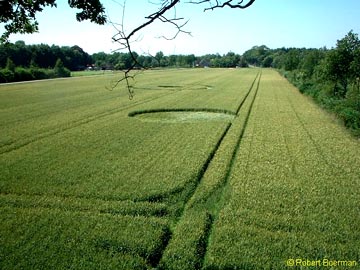
Formation Measurements:
- The single circle in the foreground is about 13.70 meters (45 feet) and has a 20-centimeters-wide (8 inches) border pressed down deeply around the inside of its perimeter. All wheat crops laid down counter-clockwise.
- The ringed circle in the background is about 23 meters (75 feet) in diameter and has a 20-centimeters-wide (8 inches) border pressed down deeply on the inside perimeter of the ring. The ring’s width is 2 meters.10 (7 feet). All wheat crops laid down counter-clockwise.
- The circle at the middle of the ring is about 6 meters. 75 (22 feet) and also has a 20-centimeters-wide (8 inches) border pressed down deeply around the inside of its perimeter.
- The standing crop between the ring and central flat circle is 5 meters.70 (4.5 feet)
Interview:
Robert Boerman, Dutch Crop Circle Archive (www.dcca.nl), Brummen, Holland: “When we entered the field, my nephew said, ‘Ah, look at that!’ It was a beautiful lay, really!
ALL OF THE PLANTS IN EVERY PART OF THE FORMATIONS WERE LAID IN A COUNTER-CLOCKWISE ROTATION?
Yes, that is correct. Then there was the unusual part. It looked like three thin rings only 20 centimeters wide that were different from the rest of the formations that we could see because the plants were pressed lower than the rest of the formations. For example, in the single circle, there was this narrow band going around the inside perimeter of the circle, but it was all the same direction to the left, counter-clockwise, only a bit lower than the rest of the downed plants in the circle. Really strange.
I think the ring of 20 centimeters was flattened first and then the rest of the circle. It looked like that because they were overlapping each other.
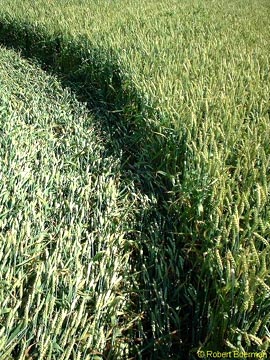
IN THAT 20 CENTIMETER RING, COULD YOU SEE ANY DAMAGE TO THE CROP AS IF IT HAD BEEN PUSHED DOWN HARD BY SOME FORCE?
No, nothing. Nothing at all just as the farmer told me, ‘Absolutely nobody had entered the field before I did.’
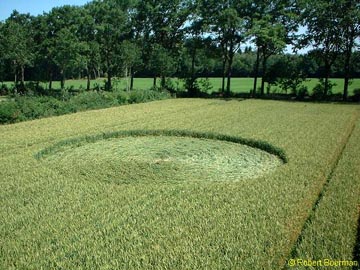
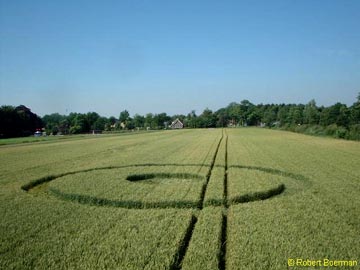
SOME PEOPLE WOULD ARGUE, ‘WELL, THERE IS A TRAMLINE GOING RIGHT THROUGH THE RINGED CIRCLE AND RIGHT ALONG THE EDGE OF THE BIG CIRCLE AND THEY WOULD BE EASY TO WALK INTO TO MAKE THESE PATTERNS.’ WHAT DO YOU THINK?
Yeah, that is possible, but the farmer said there was some grass growing in the tramlines and absolutely no traces at all (of footprints). The ground was soft, so if you walk inside it you have to damage the soft plants and soil. But he said there were no traces at all. When we walked around the big ring, you could exactly see where we put our feet, our tracks were clear.
DID ANYONE SEE OR HEAR ANYTHING UNUSUAL?
No. I asked the farmer if anyone saw lights or even that cylindrical cloud (reported by two people at Oss on July 9). But he said no one had reported anything, ‘Nothing at all.'”
More Information:
291 Crop Formations in Holland, 1990 – 2003
2003, as of July 16: 8
2002: 21
2001: 17
2000: 18
1999: 19
1998: 19
1997: 43
1996: 100
1995: 7
1994: 30
1993: 7
1992: 0
1991: 1
1990: 1
Websites:
http://www.cropcircleconnector.com
http://home.clara.net/lucy pringle
http://www.invisiblecircle.de and http://www.invisiblecircle.org/ser/d-archiv-2003.html
http://www.cropcircleresearch.com
http://www.temporarytemples.co.uk
http://www.busty-taylor.com/cropper/98busty2.htm
© 1998 - 2025 by Linda Moulton Howe.
All Rights Reserved.

